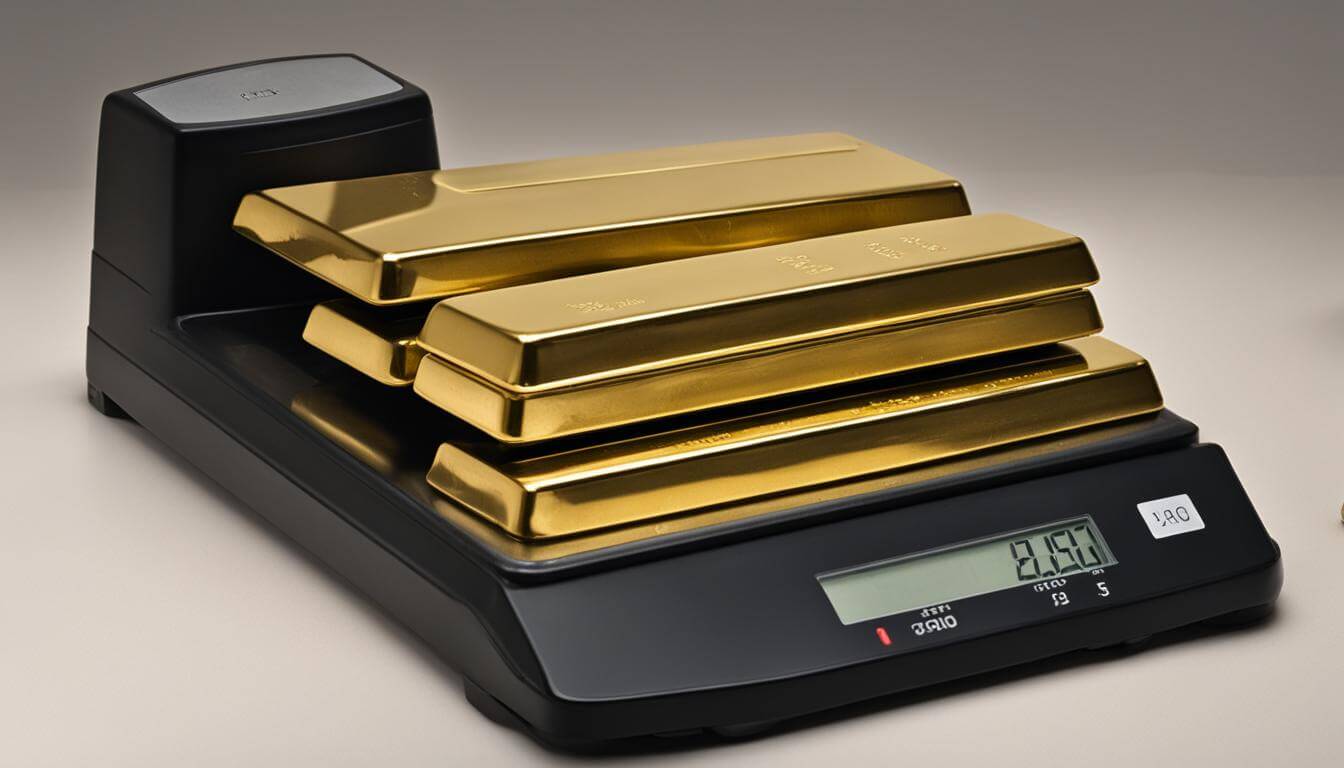Gold bars have been a symbol of wealth and prosperity for centuries, and their value often fluctuates with the economic climate. As an investor or industry professional, understanding the weight of a gold bar in pounds is crucial when assessing its value and potential profit.
In the United States, gold bars are typically weighed in avoirdupois pounds, which is equivalent to 16 ounces or 0.453592 kilograms per pound. However, the weight of a gold bar can vary depending on a number of factors, as we will explore in this article.
Key Takeaways
- Gold bars are commonly weighed in avoirdupois pounds in the United States.
- Several factors can influence the weight of a gold bar, including purity, alloy composition, and production techniques.
- Different types of gold bars can also have variations in weight.
- Professional equipment and techniques are used to accurately weigh gold bars and ensure their authenticity and value.
- Popular gold bar weights in the United States are widely recognized and significant in the gold market.
Understanding the Standard Weight of a Gold Bar
Gold bars come in various weights and sizes, but their weight is an essential factor in determining their value. The standard weight of a gold bar is measured in troy ounces and is internationally recognized as one of the main parameters for gold bullion trading. However, in the United States, the weight is often measured in pounds, which is a more commonly used unit of mass in the country.
The standard weight of a gold bar is 400 troy ounces or around 27.5 pounds. This weight is typically used by the London Bullion Market Association (LBMA) for ‘good delivery’ bars, which are gold bars that meet international trading standards. LBMA-approved gold bars must have a minimum purity of 99.5% and a maximum allowable weight of 13.5 kilograms or around 400 ounces.
To determine the weight of a gold bar, industry professionals use a precision electronic scale that can measure up to the nearest 0.1 gram. Gold bars are also usually stamped with their weight and purity, which provide vital information for buyers and sellers.
The standard weight of a gold bar is important as it establishes a universal standard for gold bullion trading, enabling buyers and sellers to transact on a level playing field. It also serves as a benchmark for determining the value of other types of gold investments, such as gold coins and ETFs.
“The standard weight of a gold bar is a crucial element in the global gold market, as it ensures the quality, purity, and value of gold bullion.
While the standard weight of gold bars is essential for the industry, certain factors can influence the weight of gold bullion, as we’ll explore in the next section. Understanding these factors is crucial for buyers and sellers as they can affect the value and authenticity of gold bars.
Factors Influencing the Weight of Gold Bullion
When it comes to the weight of gold bullion, several factors can influence its final weight in pounds. One of the essential factors is purity. The higher the gold purity level, the more extensive the weight of the gold bar.
Alloy composition is another crucial aspect to consider. Different metals, such as copper or silver, can be combined with gold to form an alloy, which can affect the overall weight of the gold bar. Additionally, the production technique used to extract and refine the gold can impact the final weight.
It’s worth noting that the weight of a gold bar is typically measured in troy ounces. One troy ounce is equal to 31.1035 grams or 1.0971 avoirdupois ounces. Therefore, when buying or selling gold bars, it’s essential to be familiar with these standard measurements.

Another crucial factor that may affect the weight of gold bars is the mint or refiner. Every refiner uses slightly different production techniques, which can cause variations in the final weight of their gold bars. As a result, two gold bars of the same size may have slightly different weights, depending on the producer.
It’s important to be aware of the factors influencing the weight of gold bullion to ensure that you are purchasing authentic gold bars at their correct value. By understanding these variables, investors and professionals in the gold market can make informed decisions based on the actual weight of the gold bullion they are handling.
Variations in Gold Bar Weights
Gold bars come in various weights, depending on the type and production process used. Two primary types of gold bars exist in the market: cast and minted. Cast bars are made by pouring molten gold into a cast while minted bars are pressed or stamped to achieve their shape. The production process influences the weight of the gold bars, contributing to weight variations that exist in the market.
Did you know? Minted gold bars have precision-cut edges and smooth surfaces, giving them a sleek appearance. Cast gold bars, on the other hand, have an uneven surface and rough edges, reflecting the production process used.
The weight of a gold bar has a direct impact on its value, and even slight variations can cause price differences. The table below highlights some of the common gold bar weights and their corresponding measurements in troy ounces and grams:
| Gold Bar Weight | Troy Ounces | Grams |
|---|---|---|
| 1 oz | 1 | 31.10 |
| 10 oz | 10 | 311.03 |
| 100 oz | 100 | 3,110.35 |
| 1 kg | 32.15 | 1,000 |
It is essential to note that not all gold bars come in standard weights, and variations exist in the market. Before purchasing gold bars, it is crucial to research and verify the authenticity of the dealer to ensure your investment is valid.
Weighing Gold Bars in Pounds
Weighing a gold bar in pounds requires specialized equipment and techniques to ensure its accuracy. Generally, professional gold buyers and sellers use top-quality digital scales or chemically treated balance scales to weigh the bars down to the last grains. The weight of a gold bar depends on various factors such as its dimension, purity, and shape, among others.
Before weighing the gold bar, the dealer needs to make sure that the scale is accurate and calibrated correctly to provide the most reliable reading. They need to check the scale’s tolerance limits, which is the maximum weight it can handle without causing errors or damages.
To ensure the authenticity of a gold bar, professional dealers also perform various tests such as ultrasonic testing, acid testing, and X-ray fluorescence. These tests verify the bar’s purity and weight, ensuring that it matches the specifications detailed on the bar.

Overall, weighing gold bars in pounds ensures that buyers and sellers can make informed decisions when trading in gold. Accurate weighing plays a vital role in determining the value and authenticity of a gold bar, making it an essential process in the gold market.
Popular Gold Bar Weights in the United States
Gold bars are available in various weight options with each of them carrying its own significance. In the United States, some of the most popularly traded gold bar weights are:
| Weight (in Ounces) | Weight (in Grams) | Weight (in Pounds) |
|---|---|---|
| 1 oz | 31.1035 | 0.068571429 |
| 10 oz | 311.035 | 0.685714286 |
| 1 kilo | 1000 | 2.20462 |
| 100 oz | 3110.35 | 6.85714 |
These weights are popular among investors and industry professionals alike due to their ease of trade, liquidity, and assured value.
investors may prefer to invest in smaller weights such as 1 oz and 10 oz bars as they offer greater flexibility while selling or trading. On the other hand, larger weights such as 1 kilo and 100 oz bars provide investors with a more cost-effective option due to the lower premium cost per ounce.
Regardless of their size, gold bars are highly treasured and remain a valuable asset in any investment portfolio.
Conclusion
As we have seen, understanding the weight of a gold bar in pounds is essential for investors and industry professionals alike. By taking into account the various factors that can influence the weight of gold bullion, individuals can make informed decisions when it comes to buying or selling gold bars in the United States.
It is crucial to be aware of the standard weight of a gold bar and the different variations in weight that can be found in the market. Additionally, knowing how to accurately weigh gold bars in pounds, using the right equipment and techniques, is essential for ensuring their authenticity and value.
Overall, the weight of a gold bar in pounds plays a significant role in the gold market and should not be overlooked. By staying informed and up-to-date on the latest industry standards and practices, investors and industry professionals can safeguard their investments and make the most of the opportunities available to them in the United States.
FAQ
How much does a gold bar weigh in pounds?
What factors can influence the weight of gold bullion?
Several factors can influence the weight of gold bullion. The purity of the gold, the alloy composition, and the production techniques used can all impact the final weight of a gold bar. Additionally, variations in the production processes of different types of gold bars, such as cast bars and minted bars, can also lead to differences in weight.
How are gold bars weighed in pounds?
Professionals in the gold industry use specialized equipment and techniques to accurately weigh gold bars in pounds. Precise weighing scales and calibrated weighing instruments are used to ensure accurate measurements. These professionals follow strict protocols and standards to maintain the integrity and authenticity of the gold bars.
What are the popular gold bar weights in the United States?
In the United States, some of the popular gold bar weights include 1 ounce, 10 ounces, and 1 kilogram. These weights are widely recognized and traded in the gold market. However, it’s important to note that there are various other weights available, catering to different investment and collection preferences.




